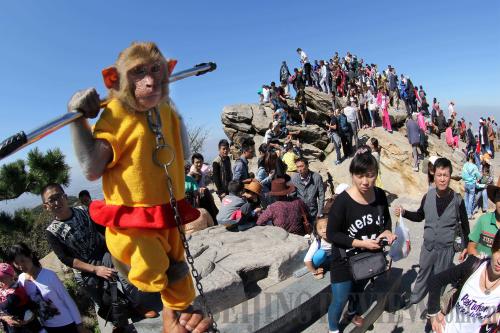|
 |
|
MONKEY KING: A monkey performs at a scenic spot in Lianyungang, Jiangsu Province, on October 3, 2013 (XINHUA) |
Xu, head of the Great Wall Circus in Suzhou, east China's Anhui Province, was beginning to worry. Usually, business would pick up around the Chinese Lunar New Year, or the Spring Festival, but not this year.
"This is the most sluggish Spring Festival season I have ever seen," he said. So far, he had not managed to land a single booking for the holiday season.
He blamed the recent slowdown in business on the stampede in Shanghai that left 36 dead on the evening of December 31, 2014, and a tiger escaping from an unlocked cage after circus performance, injuring a 12-year-old boy in Putian of Fujian Province on January 20.
In addition to these tragedies, he suggested the stronger policies on animal protection have caused an overall downturn in circus business.
In July 2010, the State Forestry Administra-tion issued a circular, banning close contact between audience members and wild animals during performances, and prohibited abusive programs such as tigers jumping through rings on fire.
In October of the same year, the Ministry of Housing and Urban Construction also released documents concerning zoo management, requesting zoos and parks under its administration to stop all animal performances.
These policies have dealt a heavy blow to the circus business, Xu told Beijing Review. He said the Great Wall Circus used to stage 400-500 performances every year, but now that number has dwindled to merely dozens.
He said that if this situation continues for another two or three years, he will have to worry about the survival of his circus.
Circus hometown hit hard
The Great Wall Circus, established in 1997, is staffed with more than 200 actors and actresses, as well as a number of animal performers.
Its website lists 20 programs starring animals, including bears using skipping ropes, lions and tigers crossing bridges and riding slides, wire walking by goats and monkeys, as well as dogs reading.
Pictures on display show a young black bear pedalling a bicycle, a tiger jumping through a hoop and lions sitting in a row.
The circus' location, Yongqiao District of Suzhou, had more than 300 circuses at the industry's peak, which made up 70 percent of the national circus market. The business took in a total revenue of hundreds of millions of yuan a year, and employing more than 20,000 people, reported local newspaper Anhui Daily.
It is not uncommon to find hundreds of lions and tigers and a more sizable number of bears and monkeys living in one village. Li Tonghai, a villager in Gaotan Village of Haogou Township, was reported to feed as many as seven lions and six tigers at a time.
Villagers train animals in the vicinity of their homes. Monkeys donning colorful clothes practice stilt walking on rural roads. Bears swing on bars in open places. Lions and tigers receive their training right in villagers' yards.
In 2008, the district's circus art was declared a national intangible cultural heritage, and was put under protection.
Almost one third of local residents make a living through the circus. Most circuses in the district travel around the country to perform outdoors. Yang Hengjun, head of Yongle Circus, said that the district's circuses have first-rate performance skills, but no modern acoustic and lighting control equipment or costumes or props, which hinders the popularization of this traditional art.
In cities, it is not easy for traveling circuses to find an open spot to perform.
City management and public safety departments usually force nomadic circuses to move away because they don't want to "invite trouble," Xu said.
Animal trainers are required to obtain a wild animal breeding license and a performance license. If they want to travel with animals, trainers are required by China's Law on the Protection of Wildlife to bring a wild animal transportation permit with them and an approval from the local forestry administration.
The procedure for obtaining the wild animal transportation permit and approval is cumbersome, Xu said. He said that it usually takes more than one month to get a permit to ship a tiger. As circus members have to travel frequently from city to city, they often cannot afford to wait for such a long time. As a result, some trainers don't bother applying.
Last July, four animal trainers from Xinye County, Nanyang of central China's Henan Province, were arrested for trafficking rare wild animals when their six monkeys performed on the street of Mudanjiang in northeast China's Heilongjiang Province.
| 